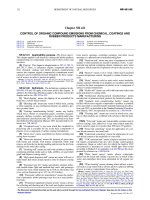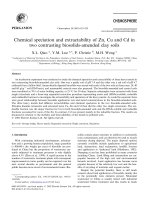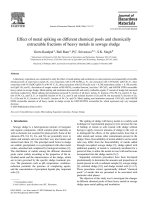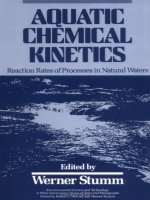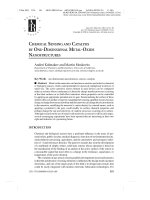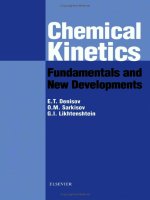chemical kinetics and reaction dynamics 2006 -upadhyay
Bạn đang xem bản rút gọn của tài liệu. Xem và tải ngay bản đầy đủ của tài liệu tại đây (1.36 MB, 265 trang )
Chemical Kinetics and
Reaction Dynamics
Chemical Kinetics and
Reaction Dynamics
Santosh K. Upadhyay
Department of Chemistry
Harcourt Butler Technological Institute
Kanpur-208 002, India
Anamaya
A C.I.P. catalogue record for the book is available from the Library of Congress
ISBN 1-4020-4546-8 (HB)
ISBN 1-4020-4547-6 (e-book)
Copublished by Springer
233 Spring Street, New York 10013, USA
with Anamaya Publishers, New Delhi, India
Sold and distributed in North, Central and South America by
Springer, 233 Spring Street, New York, USA
In all the countries, except India, sold and distributed by
Springer, P.O. Box 322, 3300 AH Dordrecht, The Netherlands
In India, sold and distributed by Anamaya Publishers
F-154/2, Lado Sarai, New Delhi-110 030, India
All rights reserved. This work may not be translated or copied in whole or in part
without the written permission of the publisher (Springer Science+Business Media,
Inc., 233 Spring Street, New York, 10013, USA), except for brief excerpts in connection
with reviews or scholarly adaptation, computer software, or by similar or dissimilar
methodology now known or hereafter developed is forbidden.
The use in this publication of trade names, trademarks, service marks and similar terms,
even if they are not identified as such, is not to be taken as an expression of opinion as
to whether or not they are subject to proprietary rights.
Copyright © 2006 Anamaya Publishers
9 8 7 6 5 4 3 2 1
springeronline.com
Printed in India.
To
My Mother
Preface
Reaction dynamics is the part of chemical kinetics which is concerned with
the microscopic-molecular dynamic behavior of reacting systems. Molecular
reaction dynamics is coming of age and much more refined state-to-state
information is becoming available on the fundamental reactions. The
contribution of molecular beam experiments and laser techniques to chemical
dynamics has become very useful in the study of isolated molecules and
their mutual interactions not only in gas surface systems, but also in solute-
solution systems.
This book presents the important facts and theories relating to the rates
with which chemical reactions occur and covers main points in a manner so
that the reader achieves a sound understanding of the principles of chemical
kinetics. A detailed stereochemical discussion of the reaction steps in each
mechanism and their relationship with kinetic observations has been considered.
I would like to take the opportunity to thank Professor R.C. Srivastava
and Professor N. Sathyamurthy with whom I had the privilege of working
and who inspired my interest in the subject and contributed in one way or
another to help complete this book. I express my heavy debt of gratitude
towards Professor M.C. Agrawal who was gracious enough for sparing time
out of his busy schedule to go through the manuscript. His valuable comments
and suggestions, of course, enhanced the value and importance of this book.
I also express my gratitude to my colleagues, friends and research students,
especially Dr. Neelu Kambo who took all the pains in helping me in preparing,
typing and checking the manuscript.
Finally, I thank my wife Mrs. Manju Upadhyay, daughter Neha and son
Ankur for their continuous inspiration during the preparation of the text.
S
ANTOSH K. UPADHYAY
Contents
Preface vii
1. Elementary 1
1.1 Rate of Reaction 1
1.1.1 Experimental Determination of Rate 2
1.2 Rate Constant 3
1.3 Order and Molecularity 4
1.4 Rate Equations 6
1.4.1 Integral Equations for n
th
Order Reaction of a Single
Reactant 6
1.4.2 Integral Equations for Reactions Involving More than
One Reactants 7
1.5 Half-life of a Reaction 8
1.6 Zero Order Reactions 10
1.7 First Order Reactions 12
1.8 Radioactive Decay as a First Order Phenomenon 17
1.9 Second Order Reactions 20
1.10 Third Order Reactions 28
1.11 Determination of Order of Reaction 30
1.11.1 Integration Method 30
1.11.2 Half-life Period Method 34
1.11.3 Graphical Method 34
1.11.4 Differential Method 35
1.11.5 Ostwald Isolation Method 35
1.12 Experimental Methods of Chemical Kinetics 39
1.12.1 Conductometric Method 39
1.12.2 Polarographic Technique 40
1.12.3 Potentiometric Method 41
1.12.4 Optical Methods 42
1.12.5 Refractometry 42
1.12.6 Spectrophotometry 43
Exercises 44
2. Temperature Effect on Reaction Rate 46
2.1 Derivation of Arrhenius Equation 46
2.2 Experimental Determination of Energy of Activation and
Arrhenius Factor 48
2.3 Potential Energy Surface 50
2.4 Significance of Energy of Activation 51
Exercises 53
3. Complex Reactions 55
3.1 Reversible Reactions 55
3.1.1 Reversible Reaction When Both the Opposing
Processes are Second Order 57
3.2 Parallel Reactions 59
3.2.1 Determination of Rate Constants 59
3.3 Consecutive Reactions 63
3.3.1 Concentration-Time Relation 64
3.4 Steady-State Treatment 66
3.5 Chain Reactions 67
3.5.1 Rate Determination 68
3.5.2 Reaction between H
2
and Br
2
69
3.5.3 Chain Length 70
3.5.4 Chain Transfer Reactions 70
3.5.5 Branching Chain Explosions 70
3.5.6 Kinetics of Branching Chain Explosion 71
3.5.7 Free Radical Chains 72
3.5.8 Chain Length and Activation Energy in Chain
Reactions 75
Exercises 76
4. Theories of Reaction Rate 79
4.1 Equilibrium and Rate of Reaction 79
4.2 Partition Functions and Statistical Mechanics of
Chemical Equilibrium 80
4.3 Partition Functions and Activated Complex 82
4.4 Collision Theory 83
4.4.1 Collision Frequency 84
4.4.2 Energy Factor 86
4.4.3 Orientation Factor 87
4.4.4 Rate of Reaction 87
4.4.5 Weakness of the Collision Theory 88
4.5 Transition State Theory 89
4.5.1 Thermodynamic Approach 91
4.5.2 Partition Function Approach 93
4.5.3 Comparison with Arrhenius Equation and Collision
Theory 93
4.5.4 Explanation for Steric Factor in Terms of Partition
Function 94
x Contents
4.5.5 Reaction between Polyatomic Molecules 95
4.6 Unimolecular Reactions and the Collision Theory 100
4.6.1 Lindemann’s Mechanism 100
4.6.2 Hinshelwood Treatment 103
4.6.3 Rice and Ramsperger, and Kassel (RRK) Treatment 105
4.6.4 Marcus Treatment 106
4.6.5 RRKM Theory 107
4.7 Kinetic and Thermodynamic Control 109
4.8 Hammond’s Postulate 110
4.9 Probing of the Transition State 111
Exercises 113
5. Kinetics of Some Special Reactions 115
5.1 Kinetics of Photochemical Reactions 115
5.1.1 Grotthuss-Draper Law 115
5.1.2 Einstein Law of Photochemical Equivalence 115
5.1.3 Primary Process in Photochemical Reactions 116
5.1.4 H
2
-Br
2
Reaction 118
5.1.5 H
2
and Cl
2
Reaction 119
5.2 Oscillatory Reactions 120
5.2.1 Belousov-Zhabotinskii Reaction 122
5.3 Kinetics of Polymerization 124
5.3.1 Step Growth Polymerization 125
5.3.2 Polycondensation Reactions (in Absence of the
Catalyst) 125
5.3.3 Acid Catalyzed Polycondensation Reaction 126
5.3.4 Chain Growth Polymerization 127
5.3.5 Kinetics of Free Radical Polymerization 127
5.3.6 Cationic Polymerization 130
5.3.7 Anionic Polymerization 131
5.3.8 Co-polymerization 132
5.4 Kinetics of Solid State Reactions 135
5.5 Electron Transfer Reactions 139
5.5.1 Outer Sphere Mechanism 139
5.5.2 Inner Sphere Mechanism 140
Exercises 141
6. Kinetics of Catalyzed Reactions 142
6.1 Catalysis 142
6.1.1 Positive Catalysis 142
6.1.2 Negative Catalysis 143
6.1.3 Auto Catalysis 143
6.1.4 Induced Catalysis 144
6.1.5 Promoters 144
Contents xi
6.1.6 Poisons 144
6.2 Theories of Catalysis 145
6.2.1 Intermediate Compound Formation Theory 145
6.2.2 Adsorption Theory 145
6.3 Characteristics of Catalytic Reactions 146
6.4 Mechanism of Catalysis 147
6.5 Activation Energies of Catalyzed Reactions 149
6.6 Acid Base Catalysis 150
6.7 Enzyme Catalysis 152
6.7.1 Influence of pH 154
6.8 Heterogeneous Catalysis 156
6.9 Micellar Catalysis 159
6.9.1 Models for Micellar Catalysis 161
6.10 Phase Transfer Catalysis 165
6.10.1 General Mechanism 166
6.10.2 Difference between Micellar and Phase Transfer-
Catalyzed Reactions 167
6.11 Kinetics of Inhibition 168
6.11.1 Chain Reactions 168
6.11.2 Enzyme Catalyzed Reactions 169
6.11.3 Inhibition in Surface Reactions 172
Exercises 173
7. Fast Reactions 175
7.1 Introduction 175
7.2 Flow Techniques 176
7.2.1 Continuous Flow Method 177
7.2.2 Accelerated Flow Method 178
7.2.3 Stopped Flow Method 178
7.3 Relaxation Method 179
7.4 Shock Tubes 181
7.5 Flash Photolysis 182
7.6 ESR Spectroscopic Technique 183
7.7 NMR Spectroscopic Techniques 183
Exercises 184
8. Reactions in Solutions 185
8.1 Introduction 185
8.2 Theory of Absolute Reaction Rate 185
8.3 Influence of Internal Pressure 187
8.4 Influence of Solvation 187
8.5 Reactions between Ions 187
8.6 Entropy Change 189
8.7 Influence of Ionic Strength (Salt Effect) 190
xii Contents
8.8 Secondary Salt Effect 192
8.9 Reactions between the Dipoles 193
8.10 Kinetic Isotope Effect 195
8.11 Solvent Isotope Effect 197
8.12 Hemmett Equation 198
8.13 Linear Free Energy Relationship 199
8.14 The Taft Equation 200
8.15 Compensation Effect 201
Exercises 202
9. Reaction Dynamics 204
9.1 Molecular Reaction Dynamics 204
9.2 Microscopic-Macroscopic Relation 205
9.3 Reaction Rate and Rate Constant 207
9.4 Distribution of Velocities of Molecules 209
9.5 Rate of Reaction for Collisions with a Distribution of
Relative Speeds 209
9.6 Collision Cross Sections 210
9.6.1 Cross Section for Hard Sphere Model 210
9.6.2 Collision between Reactive Hard Spheres 211
9.7 Activation Energy 213
9.8 Potential Energy Surface 216
9.8.1 Features of Potential Energy Surface 219
9.8.2 Ab initio Calculation of Potential Energy Surface 222
9.8.3 Fitting of ab initio Potential Energy Surfaces 225
9.8.4 Potential Energy Surfaces for Triatomic Systems 226
9.9 Classical Trajectory Calculations 229
9.9.1 Initial State Properties 230
9.9.2 Final State Properties 232
9.9.3 Calculation of Reaction Cross Section 232
9.10 Potential Energy Surface and Classical Dynamics 234
9.11 Disposal of Excess Energy 239
9.12 Influence of Rotational Energy 240
9.13 Experimental Chemical Dynamics 241
9.13.1 Molecular Beam Technique 241
9.13.2 Stripping and Rebound Mechanisms 243
9.13.3 State-to-State Kinetics 244
Suggested Readings 247
Index 251
Contents xiii
Chemical Kinetics and
Reaction Dynamics
1
Elementary
Chemical kinetics deals with the rates of chemical reactions, factors which
influence the rates and the explanation of the rates in terms of the reaction
mechanisms of chemical processes.
In chemical equilibria, the energy relations between the reactants and the
products are governed by thermodynamics without concerning the intermediate
states or time. In chemical kinetics, the time variable is introduced and rate
of change of concentration of reactants or products with respect to time is
followed. The chemical kinetics is thus, concerned with the quantitative
determination of rate of chemical reactions and of the factors upon which the
rates depend. With the knowledge of effect of various factors, such as
concentration, pressure, temperature, medium, effect of catalyst etc., on reaction
rate, one can consider an interpretation of the empirical laws in terms of
reaction mechanism. Let us first define the terms such as rate, rate constant,
order, molecularity etc. before going into detail.
1.1 Rate of Reaction
The rate or velocity of a reaction may be expressed in terms of any one of the
reactants or any one of the products of the reaction.
The rate of reaction is defined as change in number of molecules of
reactant or product per unit time, i.e.
Rate of reaction = – =
R
p
dn
dt
dn
dt
(1.1)
where dn
R
and dn
p
are the changes in number of molecules of reactant and
product, respectively, for a small time interval dt. The reactant is being
consumed, i.e. number of molecules of reactant decreases with time. Hence,
minus sign is attached so that rate will be positive numerically. For comparing
the rates of various reactions, the volume of reaction system must be specified
and rate of reaction is expressed per unit volume. If V
t
is the volume of
reaction mixture, then
Rate of reaction = –
1
=
1
t
R
t
p
V
dn
dt
V
dn
dt
(1.2)
2 Chemical Kinetics and Reaction Dynamics
At constant V,
Rate of reaction = –
(/)
=
(/)
R
p
dn V
dt
dn V
dt
(1.3)
Again n
R
/V is the molar concentration of reactant and n
p
/V the molar
concentration of product. Therefore, in terms of molar concentrations
Rate of reaction = –
[Reactant]
=
[Product]
d
dt
d
dt
(1.4)
where [Reactant] and [Product] are the molar concentrations of reactant and
product, respectively. This conventional way of representing the rate of reaction
is valid only at constant volume. However, if there is a change in the volume
of the reactants, –
dn V
dt
(/)
Rt
would yield
–
dn V
dt
V
dn
dt
n
V
dV
dt
(/)
=
1
+
()
()
Rt
t
R
R
t
2
t
⎛
⎝
⎞
⎠
(1.5)
and, therefore,
–
[Reactant]d
dt
will not be equal to –
1
t
R
t
V
dn
d
and corrections
need to be applied.
At constant volume, the rate of a general reaction, A + B → C + D in
terms of molar concentration of reactant or product may be given as
Rate of reaction = –
[A]
= –
[B]
=
[C]
=
[D]d
dt
d
dt
d
dt
d
dt
(1.6)
Rate of reaction =
Decrease in molar
concentration of a
reactant per unit time
=
Increase in molar
concentration of a
product per unit time
⎧
⎨
⎪
⎩
⎪
⎫
⎬
⎪
⎭
⎪
⎧
⎨
⎪
⎩
⎪
⎫
⎬
⎪
⎭
⎪
However, if reaction is not of a simple stoichiometry but involves different
number of moles of reactants or products, the rate should be divided by
corresponding stoichiometric coefficient in the balanced chemical equation
for normalizing it and making it comparable. For example, for a general
reaction aA + bB → cC + dD
Rate of reaction = –
1
a
[A]
= –
1
b
[B]
=
1
c
[C]
=
1
d
[D]d
dt
d
dt
d
dt
d
dt
(1.7)
1.1.1 Experimental Determination of Rate
For the determination of rate of reaction at constant volume the concentration
of a chosen reactant or product is determined at various time intervals. The
change in concentration ∆C, for a given time interval ∆t(t
2
– t
1
) is obtained.
An average rate of reaction is then obtained by calculating ∆C/∆t. The smaller
the value of ∆t, the closer the value of the rate will be to the real rate at time
(t
1
+ t
2
)/2 because
Elementary 3
lim
0∆
∆
∆
t
C
t
dC
dt
→
→
(1.8)
The rate of reaction can also be obtained by plotting concentration of
reactant or product against time and measuring the slope of the curve (dc/dt)
at the required time. The rate of reaction obtained from such method is
known as instantaneous rate. The concentration of the reactant or product
varies exponentially or linearly with time as shown in Fig. 1.1.
Slope =
[]dR
dt
Slope =
[]dP
dt
Time
[Reactant]
[Product]
Time
a
Fig. 1.1 Concentration variation of the reactant/product with time.
For determination of the instantaneous rate at any point a, the slope of the
curve is determined. It may also be noted from Fig. 1.1 that if the concentration
varies linearly with time, the slope of the curve or rate of the reaction will
remain same throughout the course of reaction. However, if concentration of
the reactant or product varies exponentially with time the slope of the curve
or the rate of reaction will be different at different time intervals. Thus, it is
not necessary that rate of reaction may always remain same throughout the
course of reaction. The reaction may proceed with a different rate in the
initial stage and may have different rate in the middle or near the end of the
reaction.
In place of concentration of reactant or product any physical property,
which is directly related with concentration, such as viscosity, surface tension,
refractive index, absorbance etc. can be measured for the determination of
the rate of reaction.
1.2 Rate Constant
For a general reaction
aA + bB → cC + dD
the rate is proportional to [A]
a
× [B]
b
, i.e.
Rate = k [A]
a
[B]
b
(1.9)
where proportionality constant k, relating rate with concentration terms, is
known as rate constant or velocity constant at a given temperature.
When the reactants are present at their unit concentrations,
Rate = k
4 Chemical Kinetics and Reaction Dynamics
Thus, the rate constant is the rate of reaction when concentrations of the
reactants are unity. The rate constant under these conditions is also known as
the specific rate or the rate coefficient. The rate constant for any reaction can
be determined
(i) either by measuring the rate of the reaction at unit concentrations of
the reactants.
(ii) or by knowing the rate at any concentration of reactant using the
relation
Rate constant = Rate/[A]
a
[B]
b
(1.10)
The rate constant is measured in units of moles dm
–3
sec
–1
/(moles dm
–3
)
n
,
where n = a + b. Time may also be in minutes or hours. It should be noted
that in case where the reaction is slow enough, the thermal equilibrium will
be maintained due to constant collisions between the molecules and k remains
constant at a given temperature. However, if the reaction is very fast the tail
part of the Maxwell-Boltzmann distribution will be depleted so rapidly that
thermal equilibrium will not be re-established. In such cases rate constant
will not truly be constant and it should be called a rate coefficient.
1.3 Order and Molecularity
For reaction
αA + βB + . . . → Product
rate of reaction is proportional to α
th
power of concentration of A, to the β
th
power of concentration of B etc., i.e.
Rate = k [A]
α
[B]
β
. . . (1.11)
Then the reaction would be said to be α
th
order with respect to A, β
th
order
with respect to B, . . . and the overall order of reaction would be α + β +
. . . . Thus, order of reaction with respect to a reactant is the power to which
the concentration of the reactant is raised into the rate law, and the overall
order of reaction is the sum of the powers of the concentrations involved in
the rate law.
The term ‘molecularity’ is the sum of stoichiometric coefficients of reactants
involved in the stoichiometric equation of the reaction. For example, a reaction
whose stoichiometric equation is
2A + 3B == 3C + 2D
the stoichiometric coefficient of A and B are 2 and 3, respectively, and,
therefore, the molecularity would be 2 + 3 = 5.
There is not necessarily a simple relationship between molecularity and
order of reaction. For differentiating between molecularity and order of a
reaction, let us consider some examples.
For the reaction, A + 2B → P, the molecularity is 1 + 2 = 3. If the reaction
Elementary 5
occurs in a single step the order of reaction with respect to A would be one
and order with respect to B would be two, giving overall order of reaction 3.
Thus the molecularity and order would be same. However, if the reaction
occurs in two different steps giving overall same reaction, e.g.
(a) A + B = I → Slow
(b)
I + B = P fast
A + 2B P
→
→
Now the rate of reaction will be governed by only slow step (a) and order of
reaction would be one with respect to each reactant, A and B, giving overall
order two. And, therefore, the order and molecularity will be different.
The inversion of cane sugar is
C
12
H
22
O
11
+ H
2
O → C
6
H
12
O
6
+ C
6
H
12
O
6
and the rate of inversion is given by
Rate = k [Sucrose] [H
2
O] (1.12)
This reaction seems to be second order, i.e. first order with respect to each
sucrose and H
2
O. The [H
2
O] is also constant as it is used as solvent and
present in large amount. Therefore, the reaction is only first order with
respect to sucrose.
The hydrolysis of ester in presence of acid is first order reaction (keeping
catalyst constant)
CH
3
COOC
2
H
5
+ H
2
O
[H ]
+
⎯→⎯
CH
3
COOH + C
2
H
5
OH
Since [H
2
O] remain constant as in case of inversion of cane sugar, it does not
effect the rate of reaction and reaction is simply first order with respect to
ester. However, the hydrolysis of ester in presence of alkali
CH
2
COOC
2
H
5
+ NaOH → CH
3
COONa + C
2
H
5
OH
is second order being first order with respect to both ester and NaOH. While
the molecularity of the reaction in each case, i.e. in hydrolysis of ester in
presence of acid as well as in presence of alkali, is two.
The reactions, in which molecularity and order are different due to the
presence of one of the reactant in excess, are known as pseudo-order reactions.
The word (pseudo) is always followed by order. For example, inversion of
cane sugar is pseudo-first order reaction.
The molecularity will always be a whole integer while order may be an
integer, fraction or even a negative number. Molecularity is a theoretical
concept, whereas order is empirical. Molecularity is, therefore, less significant
as far as kinetic studies are concerned.
The order of reaction provides the basis for classifying reactions. Generally,
the order of reaction can be anywhere between zero and three. Reactions
having order three and above are very rare and can be easily counted.
6 Chemical Kinetics and Reaction Dynamics
The rate of a chemical reaction is proportional to the number of collisions
taking place between the reacting molecules and the chances of simultaneous
collision of reacting molecules will go on decreasing with an increase in
number of molecules. The possibility of four or more molecules coming
closer and colliding with one another at the same time is much less than in
case of tri- or bi molecular reactions. Therefore, the reactions having order
four or more are practically impossible. Further, many reactions which appear
to be quite complex proceed in stepwise changes involving maximum two or
three species. The stoichiometric representation has no relation either with
the mechanism of reaction or with the observed order of reaction.
In older literature the terms unimolecular, bimolecular and termolecular
have been used to indicate the number of molecules involved in a simple
collision process and should not be confused with first, second and third
order reactions.
1.4 Rate Equations
For a reaction
nA
k
→
Product
The rate is related with concentration of A with the following differential
form of equation
Rate = –
[A]
= [A]
d
dt
k
n
(1.13)
or
log –
[A]
= log + log [A]
d
dt
kn
⎛
⎝
⎞
⎠
(1.14)
where k is the rate constant.
As discussed previously the rate is determined by drawing a graph between
concentration and time and taking the slope corresponding to a concentration.
If we have the values of the rates for various concentrations, we can find the
order of reaction by plotting log (rate) against log [concentration]. The slope
of the straight line obtained from the plot gives the order of reaction n while
the intercept gives log k. Thus, order and rate constant can be determined.
However, the average rates calculated by concentration versus time plots
are not accurate. Even the values obtained as instantaneous rates by drawing
tangents are subject to much error. Therefore, this method is not suitable for
the determination of order of a reaction as well as the value of the rate
constant. It is best to find a method where concentration and time can be
substituted directly to determine the reaction orders. This could be achieved
by integrating the differential rate equation.
1.4.1 Integral Equations for n
th
Order Reaction of a Single Reactant
Let us consider the following general reaction:
Elementary 7
nA
k
→
Product
If c
0
is the initial concentration of the reactant and c the concentration of
reactant at any time t, the differential rate expression may be given as
– dc/dt = kc
n
(1.15)
Multiplying by dt and then dividing by c
n
, we get
– dc/c
n
= kdt (1.16)
which may be integrated. The limits of integration are taken as c = c
0
and c
at t = 0 and t = t, respectively, as
∫∫
dc
c
kdt
n
=
(1.17)
For various values of n, the results may be obtained as follows:
n = 0;
k
Cc
t
=
–
0
n = 1; ln c = ln (c
0
) – kt or c = c
0
e
–kt
n = 2; k = 1/t [1/c – 1/c
0
]
n = 3; k = 1/2t [1/c
2
– 1/
c
0
2
]
n = n; k = 1/(n–1)t [1/(c
n–1
) – 1/(
c
n
0
–1
)]
1.4.2 Integral Equations for Reactions Involving
More than One Reactants
When the concentrations of several reactants, and perhaps also products,
appear in the rate expressions, it is more convenient to use as the dependent
variable x, i.e. the decrease in concentration of reactant in time t. Then
c = a – x, where a is commonly used to indicate the initial concentration in
place of c
0
and rate equation (1.15) becomes
dx/dt = k (a – x)
n
(1.18)
or
∫∫
dx a x kdt
n
/( – ) =
which can be integrated taking the conditions: at t = 0 , x will also be zero,
the value of rate constant can be obtained.
For various values of n the results obtained are as follows:
n = 0 dx/dt = k; k = x/t
n = 1 dx/dt = k(a – x); k = 2.303/t log a/a – x
n = 2 dx/dt = k(a – x)
2
; k = 1/t [1/a – x – 1/a]
8 Chemical Kinetics and Reaction Dynamics
n = 3 dx/dt = k(a – x)
3
; k = 1/2t [1/(a – x)
2
– 1/a
2
]
n = ndx/dt = k(a – x)
3
; k = 1/(n – 1)t [1/(a – x)
n–1
– 1/a
n–1
]; n ≥ 2
1.5 Half-life of a Reaction
The reaction rates can also be expressed in terms of half-life or half-life
period. The half-life period is defined as the time required for the concentration
of a reactant to decrease to half of its initial value.
Hence, half-life is the time required for one-half of the reaction to be
completed. It is represented by t
1/2
and can be calculated by taking t = t
1/2
when x = a/2 in the integrated rate equation of its order.
Problem 1.1 Write the differential rate equations of the following reactions:
(a) A + 2B
k
→
P
(b) 3A + 2B
′
→
k
3C + D + 2E
Solution The differential rates of above reactions can be written assuming
them to be elementary steps
(a)
–
[A]
= –
1
2
[B]
=
[P]
= [A] [B]
2
d
dt
d
dt
d
dt
k
(b)
–
1
3
[A]
= –
1
2
[B]
=
1
3
[C]
=
[D]
=
1
2
[]
= [A] [B]
32
d
dt
d
dt
d
dt
d
dt
dE
dt
k
′
Problem 1.2 Write the differential rate equations of the following reactions:
(a) A + 3B → 4C
(b) A + 2B → C + 3D
(c) 3A + B + 2C → D + 3E
Solution Assuming these reactions as elementary steps, the differential rate
can be written as:
(a)
–
[A]
= –
1
3
[B]
=
1
4
[C]
= [A][B]
3
d
dt
d
dt
d
dt
k
(b)
–
[A]
= –
1
2
[B]
=
[C]
=
1
3
[D]
= [A][B]
2
d
dt
d
dt
d
dt
d
dt
k
(c)
–
1
3
[A]
= –
[B]
= –
1
2
[C]
=
[D]
=
1
3
[]
= [A] [B][C]
32
d
dt
d
dt
d
dt
d
dt
dE
dt
k
Problem 1.3 Express the rate constant k in unit of dm
3
mol
–1
s
–1
, if
(i) k = 2.50 × 10
–9
cm
3
molecule
–1
s
–1
(ii) k = 2 × 10
–6
s
–1
atm
–1
Elementary 9
Solution
(i) 1 dm
3
= 1000 cm
3
, i.e. 1 cm
3
= 10
–3
dm
3
1 mol = 6.02 × 10
23
molecule
molecule
–1
= 6.02 × 10
23
mol
–1
k = 2.50 × 10
–9
cm
3
molecule
–1
s
–1
= 2.50 × 10
–9
(10
–3
dm
3
)(6.02 × 10
23
mol
–1
)s
–1
= 2.50 × 6.02 × 10
–9–3+23
dm
3
mol
–1
s
–1
= 15.05 × 10
11
dm
3
mol
–1
s
–1
(ii) We know
P
n
RT CRT
(1 atm)
= =
v
or
C
P
RT
= =
1 atm
0.0821 atm dm mol K 273 K
3–1–1
×
= 0.0446 mol dm
–3
Therefore, 1 atm = 0.0446 mol dm
–3
or 1 atm
–1
=
1
0.0446
mol dm
–1 3
k = 2.0 × 10
–6
s
–1
atm
–1
= 2.0 × 10
–6
s
–1
.
1
0.0446
⎛
⎝
⎞
⎠
mol
–1
dm
3
= 44.8 × 10
–6
dm
3
mol
–1
s
–1
Problem 1.4 For a certain reaction, the value of rate constant is 5.0 × 10
–3
dm
3
mol
–1
sec
–1
. Find the value of rate constant in (i) dm
3
molecule
–1
sec
–1
(ii) cm
3
mol
–1
sec
–1
and (iii) cm
3
molecule
–1
sec
–1
.
Solution
(i) in dm
3
mol
–1
sec
–1
Rate constant = 5.0 × 10
–3
dm
3
mol
–1
sec
–1
1 mol = 6.02 × 10
23
molecules
Rate constant = 5.0 × 10
–3
dm
3
(6.02 × 10
23
mol)
–1
sec
–1
= 0.83 × 10
–26
dm
3
molecule
–1
sec
–1
(ii) in cm
3
mol
–1
sec
–1
1 dm
3
= 1000 cm
3
10 Chemical Kinetics and Reaction Dynamics
Rate constant = 5.0 × 10
–1
dm
3
mol
–1
sec
–1
= 5.0 × 10
–3
(1000) cm
3
mol
–1
sec
–1
= 5.0 cm
3
mol
–1
sec
–1
(iii) in cm
3
molecules
–1
sec
–1
Rate constant = 5.0 cm
3
(6.02 × 10
23
)
–1
molecules
–1
sec
–1
= 0.83 × 10
–23
cm
3
molecules
–1
sec
–1
1.6 Zero Order Reactions
When no concentration term affects the rate of reaction, or the rate of reaction
remains same throughout the reaction, the reaction is known as zero-order
reaction.
Let us consider a reaction
A→ Product
Since the rate of reaction remains same
dx
dt
k =
On integrating the expression as
∫∫
dx k dt =
we get
x = kt + z
The value of integration constant z may be obtained by taking the conditions
x = 0, when t = 0, the value of z is zero and, therefore, rate equation becomes
xkt k
x
t
= or =
(1.19)
which gives the unit of rate constant as mol dm
–3
sec
–1
or conc. (time)
–1
in
general.
• The half-life period t
1/2
of a zero order reaction can be calculated with the
help of equation (1.19), taking t = t
1/2
and x = a/2 as
t
a
k
1/2
=
2
(1.20)
Thus, the half-life period of zero order reaction is directly proportional to
the initial concentration of the reactant. For example, on increasing the
initial concentration by two fold, the half-life period of the reaction would
also be double.
Elementary 11
• According to equation (1.19) the slope of a plot of x or (a – x) (i.e. the
concentration of product or concentration of reactant) versus time will
give the value of rate constant k (Fig. 1.2).
t
t
x
(a – x)
Slope = k
Slope = k
Intercept = a
Fig. 1.2 Concentration versus time plot for zero order reaction.
The combination of H
2
and Cl
2
to form HCl in presence of sunlight is a
zero order reaction
H
2
+ Cl
2
→ 2HCl
The rate of formation of HCl is not affected by a change in concentration
of either the reactant or product. However, it is influenced by the intensity of
sun light.
Problem 1.5 A zero order reaction is 50% complete in 20 min. How much
time will it take to complete 90%?
Solution Let a = 100 mol dm
–3
. For a zero-order reaction
k
x
t
= =
50 (mol dm )
20 60 (sec)
–3
×
When reaction is 90% completed, x = 90. Therefore,
Thus,
50
1200
=
90
t
or
t =
90 1200
50
= 2160 sec = 36 min
×
Problem 1.6 A reaction is 50% complete in 20 min. How much time will be
taken to complete 75% reaction?
Solution For a zero order reaction
k = x/t
x = a/2 for 50%
k
a
t
a
=
2
=
2 20×
x
a
=
3
4
for 75% reaction
12 Chemical Kinetics and Reaction Dynamics
Therefore,
k
a
t
=
3
4
or
aa
t2 20
=
3
4×
t =
40 3
4
= 30 min
×
75% reaction will complete in 30 min.
1.7 First Order Reactions
Let us consider a first-order reaction
A
⎯→⎯⎯
Products
Initially, a 0
At time t, a – xx
We know that in case of a first-order reaction, the rate of reaction, dx/dt
is directly proportional to the concentration of the reactant. Therefore,
dx
dt
ka x = ( – )
or
dx
ax
kdt
(–)
=
Integrating, we get ln (a – x) = kt + z.
The integration constant z is determined by putting t = 0 and x = 0. Thus
z = ln a
and, therefore, the rate constant for a first order reaction is obtained as
k
t
a
ax
=
1
ln
–
or
k
t
a
ax
=
2.303
log
–
(1.21)
• The units of rate constant for a first order reaction from equation (1.21) is
measured as (time)
–1
and can be represented as sec
–1
, min
–1
or hour
–1
.
• The half-life period for a first-order reaction may be obtained from equation
(b) by substituting t = t
1/2
when x = a/2, i.e.
k
t
a
aa
=
2.303
log
– /2
1/2
or
t
k
1/2
=
2.303 log2
(1.22)
Thus, the half-life period of a first-order reaction is independent of initial
concentration of reactant. Irrespective of how many times the initial
concentration of reactant changes, the half-life period will remain same.
Elementary 13
• Further, equation (1.21) can be rearranged as
log ( – ) = –
2.303
+ log ax
k
ta
(1.23)
which suggests that a plot of log (a – x) versus time will give a straight line
with a negative slope (k/2.303) and
an intercept log a (Fig. 1.3).
Thus, in case of a first-order
reaction a plot between log [conc.]
and time will always be linear and
with the help of slope, the value of
rate constant can be obtained.
Examples
1. Inversion of cane sugar (sucrose)
log (a – x)
log a
t
Slope = k/2.303
Fig. 1.3 The log [conc.] versus time plot
for first-order reaction.
C H O + H O C H O + C H O
12 22 11 2
6
12
6
D-glucose
6
12
6
D-fructose
→
The reaction is pseudo-first order and rate is proportional to [Sucrose]. The
progress of the reaction can be studied by measuring the change in specific
rotation of a plane of polarised light by sucrose. Let r
0
, r
t
and r
∞
are the
rotation at initially (when t = 0), at any time t and final rotation, respectively.
The initial concentration a is proportional to (r
0
– r
∞
) and concentration at
any time t, (a – x) is proportional to (r
0
– r
t
). Thus, the rate constant may be
obtained as
k
t
rr
rr
t
=
2.303
log
( – )
( – )
0
∞
∞
(1.24)
2. The hydrolysis of ester in presence of acid
CH COOC H + H O CH COOH + C H OH
32
(–)
5
2
H
3
()
2
5
+
ax
x
⎯→⎯
Rate = k [ester]
Since one of the product is acetic acid, the progress of reaction may be
studied by titrating a known volume of reaction mixture against a standard
alkali solution using phenolphthalein as indicator. Let V
0
, V
t
and V
∞
be the
volumes of alkali required for titrating 10 ml of reaction mixture at zero
time, at any time t and at the completion of the reaction, respectively.
V
0
= Amount of H
+
(catalyst) present in 10 ml of reaction mix.
V
t
= Amount of H
+
(catalyst) in 10 ml of reactions mix + Amount of CH
3
COOH
formed at any time t.
V
∞
=Amount of H
+
(catalyst) present in 10 ml of reaction mix + Amount of
CH
3
COOH formed at the end of reaction (or amount of ester present
initially because 1 mol of ester gives 1 mol of CH
3
COOOH).
14 Chemical Kinetics and Reaction Dynamics
Thus, we can take V
∞
– V
0
= a
V
t
– V
0
= x
or (V
∞
– V
0
) – (V
t
– V
0
) = V
∞
– V
t
= a – x
Therefore, the rate constant for the reaction may be obtained as
k
t
VV
VV
t
=
2.303
log
( – )
( – )
0
∞
∞
(1.25)
3. Decomposition of N
2
O
5
N
2
O
5
→ 2 NO
2
+
1
/
2
O
2
Nitrogen pentaoxide in carbon tetrachloride solution decomposes to give O
2
.
The progress of reaction is monitored by measuring the volume of O
2
at
different time intervals and using the relation
k
t
V
VV
t
=
2.303
log
–
∞
∞
(1.26)
where V
∞
is the final value of O
2
when reaction is complete and corresponds
to initial concentration of N
2
O
5
, V
t
is the value of O
2
at any time t and
(V
∞
– V
t
) corresponds to (a – x).
4. Decomposition of H
2
O
2
in aqueous solution
HO HO + O
22
Pt
2
→
The concentration of H
2
O
2
at different time intervals is determined by titrating
the equal volume of reaction mixture against standard KMnO
4
.
Problem 1.7 The specific rotation of sucrose in presence of hydrochloric
acid at 35°C was measured and is given as follows:
Time (min) 0 20 40 80 180 500 ∞
Rotation (°C) 32.4 28.8 25.5 19.6 10.3 6.1 –14.1
Calculate the rate constant at various time intervals and show that the reaction
is first order.
Solution
k
t
a
ax t
rr
rr
t
=
2.303
log
–
=
2.303
log
–
–
0
∞
∞
k
20
–1
=
2.303
20
log
32.4 – (–14.1)
28.8 – (–14.1)
= – .00403 min
k
40
–1
=
2.303
40
log
32.4 – (–14.1)
25.5 – (–14.1)
= – .00406 min

